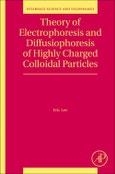Theory of Electrophoresis and Diffusiophoresis of Highly Charged Colloidal Particles discusses the electrophoretic and diffusiophoretic motions of various colloidal entities, such as rigid particles, liquid droplets, gas bubbles, and porous particles, focusing on the motion-deterring double-layer polarization effect pertinent to highly charged particles, with the lowly charged ones serving as the limiting cases. Boundary effects such as those from a cylindrical pore, a solid plane, or an air-water interface are analyzed as well for the electrophoretic motion of the various particles considered. Dynamic electrophoresis is also explored and treated.
The contents are suitable for researchers, graduate students, or senior college students with some basic background of colloid science and transport phenomena. As there is no closed-form analytical formula in general for the situation of highly charged particles, the results are presented with extensive figures and plots as well as tables under various electrokinetic situations of interest to facilitate the possible use of interested readers.
Please Note: This is an On Demand product, delivery may take up to 11 working days after payment has been received.
Table of Contents
Part I. Electrophoresis of Rigid Particles 1. Polarization of Electrical Double Layer of a Highly Charged Spherical Particle 2. Concentrated Suspensions of Particles and Double Layer Overlapping 3. The Motion of a Particle Near a Solid Plane 4. The Motion of a Particle Near an Air-Water Interface 5. The Motion of a Particle Through a Cylindrical Pore 6. Dynamic Electrophoresis
Part II. Soft Particles and Porous Media 7. Behaviors in a Concentrated Suspension 8. Boundary Effects with a Nearby Solid Plane or Air-Water Interface 9. Particle Motion Through a Cylindrical Pore and Applications 10. Dynamic Electrophoresis of Soft Particles 11. Gel-Electrophoresis in Suspensions and Near Planar Boundaries
Part III. Liquid Drops 12. Behaviors in a Concentrated Suspension 13. Impact of Nearby Planar Boundaries 14. Motion Through a Cylindrical Pore 15. Dynamic Electrophoresis of Liquid Drops
Part IV. Diffusiophoresis 16. Behaviors in Concentrated Suspensions of Rigid Particles 17. Particle Motions with Nearby Boundaries and Potential Applications in Microfluidics 18. Behaviors of Nonrigid Particle Systems








